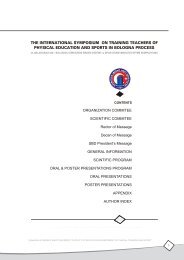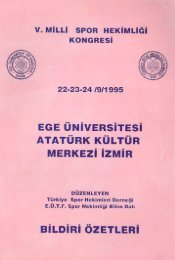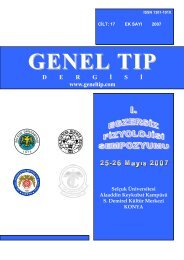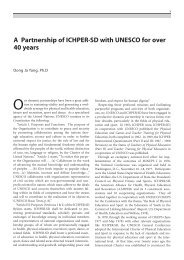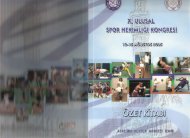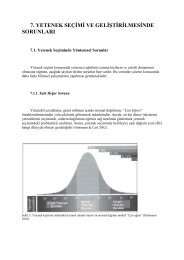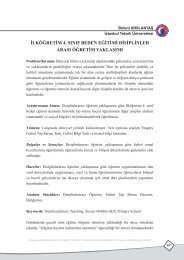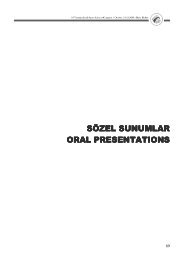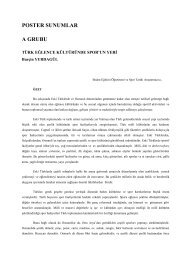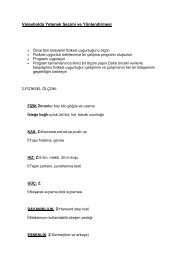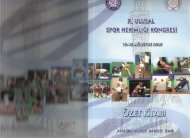7.ULUSLARARASI SPOR BİLİMLERİ KONGRESİ27-29 EKİM 2002KONGRE - PANELLER3. Jet-lag and performanceIt is difficult for practical reasons to demonstrate scientifically a direct influence of jet-lag on exerciseperformance. The reasons for this are complex, including the variability inherent in performance itself. Oncethe athlete has embarked on the long-haul flight, the circadian rhythms are disrupted, including the rhythm inperformance itself. Measuring all-out performance is appropriate for some sports, but the critical question is ‗Atwhich time of day should performance be measured?‘ Monitoring repeatedly in order to outline circadiancharacteristics is theoretically the ideal, but is likely to induce fatigue thereby masking the underlying rhythm.Despite these difficulties, the evidence for adverse effects of jet-lag on game performance is robust.American footballers travelling from western to central or eastern zones were found to be detrimentally affected,except when matches were played at night. Teams from the West Coast playing at home in the evening hadthe advantage over visitors. When going eastwards, overall mean performance was depressed more and peakperformance declined more than was the case when teams travelled westwards. The explanation is that thebody clock adjusts more easily to a phase delay (or lengthening) than to an advance (shortening), its naturalperiod being about 26 rather than 24 h. A modification of the training times for a few days before departure toreplicate the time of competition in the other time-zone has proved beneficial for American footballers (Jehue etal., 1993).It is more common to infer changes in performance from discrete observations on athletes. The normalsuperiority of evening compared to morning measurements of muscular strength was reversed for five days inRugby League players arriving in Australia from England (Reilly and Mellor, 1988). Once the rhythm in bodytemperature was restored to its normal aerophase, symptoms of jet-lag disappeared.The effects of jet-lag were also monitored in British Olympic male gymnasts following a flight from Londonto Tallahassee (Reilly et al., 2001). Measures included body temperature, leg strength, back strength, choicereaction times and jet-lag symptoms, all recorded 4 times a day on alternate days for 7 days. The sleep-wakecycle re-stabilised first, then core temperature; jet-lag symptoms disappeared coincidentally with the reestablishmentof the temperature rhythm. Only when the temperature rhythm was re-aligned did theperformance measures demonstrate normal rhythmicity (Figure 2).Figure 2. Values for rating of jet-lag 5 times a day from day 1 to day 10 inclusive.It was concluded that allowing one day to adapt for each time-zone crossed was inadequate for allsubjects to adjust fully to the new local time.An indication of the length of time a group of athletes takes to adjust to a long-haul flight eastwards isshown in Figure 2. Jet-lag symptoms were monitored in Olympic participants travelling to Australia fromEngland. In this instance, not al subjects had adjusted by 10 days.348
7.ULUSLARARASI SPOR BİLİMLERİ KONGRESİ27-29 EKİM 2002KONGRE - PANELLER4. Coping with jet-lagThere have been very many remedies suggested for alleviating or eliminating jet-lag. Some of thesehave had little substantial rationale, others have had theoretical backing but limited empirical evidence. Onlythe major approaches are mentioned here.4.1 Pre-flight adjustmentIt is thought that adjustment of the body clock prior to a long journey should eliminate jet-lag after theflight. This adjustment is attempted by altering the timing of sleep and activity, delaying bed-time before awestward flight and retiring early before an eastward flight. Reilly and Maskell (1989) examined theconsequences of phase delays and phase advances of 3 h, 4 h and 5 h. They reported it was not useful to tryto adjust fully to a time-zone transition prior to the journey since this intervention interrupts lifestyle and trainingtoo much and has only minor effects on adjusting the body clock. Only the sleep-wake (rather than the lightdark)cycle is manipulated and many travellers will not have opportunity even to do this. A benefit of a minoradjustment is that it can begin to shift the body clock in the desired direction, in the event of a long-haul flightcrossing 9 or more time-zones to the east.4.2 Timing and composition of mealsIt has been suggested that high-protein breakfasts promote alertness and that high-carbohydrate eveningmeals (vegetables, potatoes, rice, bread, pasta, desserts, etc.) promote sleep (Graeber et al., 1981). Thetheoretical grounds for this include the effects upon plasma amino acids that such meals would have and ,thence, the uptake of the amino acids into the brain, their incorporation into neurotransmitters, and the releaseof the neurotransmitters. High protein meals (meat, cheese, eggs, etc.) undoubtedly raise plasma tyrosine, butwhether this promotes the release of catecholamines by the activating systems of the brain and so promotesalertness, is less clear. Similarly, high-carbohydrate meals elevate the concentration of plasma tryptophan, butwhether this stimulates the raphé nucleus and sleep is also uncertain (Leathwood, 1989).Electroencephalographic waves have shown some changes in athletes on a carbohydrate rich diet, but effectson the quality of sleep have not been demonstrated. The two-phase dietary method was promoted in the USAunder the title ‗President Reagan‘s Anti-jet-lag-Diet‘ (Ehret and Scanlon, 1983).Scientific tests of the efficacy of the diet are few and poorly designed. Even so, a variant of this proposalhas been marketed. It consists of two types of pills, one to be taken in the morning and the other in the evening.Each pill is a mixture of substances, the morning pill containing tyrosine and the evening one, tryptophan. Theaccompanying literature does not enable a judgement to be made on the scientific evaluation of thesepreparations. Besides, tryptophan achieved adverse publicity in the early 1990s owing to the finding ofimpurities in commercially available products and its use is no longer recommended.4.3 Sleeping pillsDisturbance of sleep is one of the unwanted corollaries of jet-lag syndrome. Resynchronising the normalsleep-wakefulness cycle seems to occur first, prior to restoration of physiological and performance measures totheir normal circadian rhythm.Although drugs, such as benzodiazepines, are effective in getting people to sleep, they do not guaranteea prolonged period asleep. Besides, they have not been satisfactorily tested for subsequent residual effects onmotor performance, such as sports skills. They may be counter-productive if given at the incorrect time. Aprolonged sleep at the time an individual feels drowsy (presumably when he or she would have been asleep inthe time-zone departed from) simply anchors the rhythms at their former phases and so operates againstadjustment to the new time-zone.The administration of one benzodiazepine (temazepam) was found to have no influence on subjective,physiological and performance measures following a westward flight across five time zones. The circadianrhythms of athletes differed from those of sedentary subjects, although neither group benefited from the349



